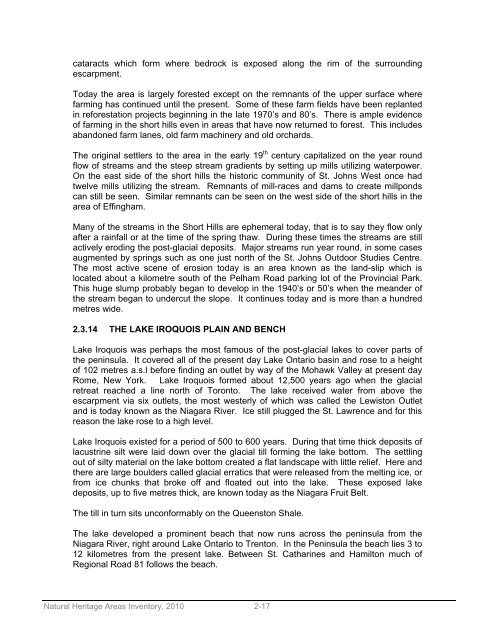2.0 Watershed Geologic Characterization.pdf - Niagara Peninsula ...
2.0 Watershed Geologic Characterization.pdf - Niagara Peninsula ...
2.0 Watershed Geologic Characterization.pdf - Niagara Peninsula ...
Create successful ePaper yourself
Turn your PDF publications into a flip-book with our unique Google optimized e-Paper software.
cataracts which form where bedrock is exposed along the rim of the surrounding<br />
escarpment.<br />
Today the area is largely forested except on the remnants of the upper surface where<br />
farming has continued until the present. Some of these farm fields have been replanted<br />
in reforestation projects beginning in the late 1970’s and 80’s. There is ample evidence<br />
of farming in the short hills even in areas that have now returned to forest. This includes<br />
abandoned farm lanes, old farm machinery and old orchards.<br />
The original settlers to the area in the early 19 th century capitalized on the year round<br />
flow of streams and the steep stream gradients by setting up mills utilizing waterpower.<br />
On the east side of the short hills the historic community of St. Johns West once had<br />
twelve mills utilizing the stream. Remnants of mill-races and dams to create millponds<br />
can still be seen. Similar remnants can be seen on the west side of the short hills in the<br />
area of Effingham.<br />
Many of the streams in the Short Hills are ephemeral today, that is to say they flow only<br />
after a rainfall or at the time of the spring thaw. During these times the streams are still<br />
actively eroding the post-glacial deposits. Major streams run year round, in some cases<br />
augmented by springs such as one just north of the St. Johns Outdoor Studies Centre.<br />
The most active scene of erosion today is an area known as the land-slip which is<br />
located about a kilometre south of the Pelham Road parking lot of the Provincial Park.<br />
This huge slump probably began to develop in the 1940’s or 50’s when the meander of<br />
the stream began to undercut the slope. It continues today and is more than a hundred<br />
metres wide.<br />
2.3.14 THE LAKE IROQUOIS PLAIN AND BENCH<br />
Lake Iroquois was perhaps the most famous of the post-glacial lakes to cover parts of<br />
the peninsula. It covered all of the present day Lake Ontario basin and rose to a height<br />
of 102 metres a.s.l before finding an outlet by way of the Mohawk Valley at present day<br />
Rome, New York. Lake Iroquois formed about 12,500 years ago when the glacial<br />
retreat reached a line north of Toronto. The lake received water from above the<br />
escarpment via six outlets, the most westerly of which was called the Lewiston Outlet<br />
and is today known as the <strong>Niagara</strong> River. Ice still plugged the St. Lawrence and for this<br />
reason the lake rose to a high level.<br />
Lake Iroquois existed for a period of 500 to 600 years. During that time thick deposits of<br />
lacustrine silt were laid down over the glacial till forming the lake bottom. The settling<br />
out of silty material on the lake bottom created a flat landscape with little relief. Here and<br />
there are large boulders called glacial erratics that were released from the melting ice, or<br />
from ice chunks that broke off and floated out into the lake. These exposed lake<br />
deposits, up to five metres thick, are known today as the <strong>Niagara</strong> Fruit Belt.<br />
The till in turn sits unconformably on the Queenston Shale.<br />
The lake developed a prominent beach that now runs across the peninsula from the<br />
<strong>Niagara</strong> River, right around Lake Ontario to Trenton. In the <strong>Peninsula</strong> the beach lies 3 to<br />
12 kilometres from the present lake. Between St. Catharines and Hamilton much of<br />
Regional Road 81 follows the beach.<br />
Natural Heritage Areas Inventory, 2010 2-17

















